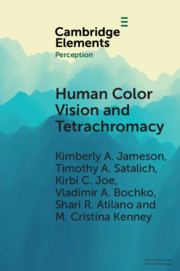Element contents
Human Color Vision and Tetrachromacy
Published online by Cambridge University Press: 12 May 2020
Summary
Keywords
- Type
- Element
- Information
- Series: Elements in PerceptionOnline ISBN: 9781108663977Publisher: Cambridge University PressPrint publication: 25 June 2020
References
- 13
- Cited by



